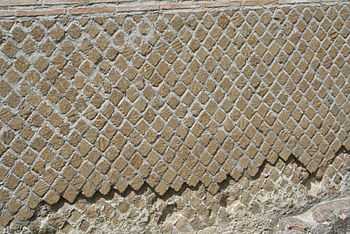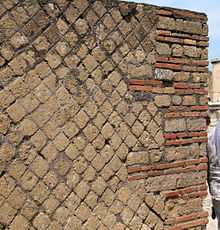Opus reticulatum

Opus reticulatum (also known as reticulated work) is a form of brickwork used in ancient Roman architecture. It consists of diamond-shaped bricks of tuff, referred to as cubilia,[1] placed around a core of opus caementicium.[2] The diamond-shaped tufa blocks were placed with the pointed ends into the cement core at an angle of roughly 45 degrees, so the square bases formed a diagonal pattern, and the pattern of mortar lines resembled a net. Reticulatum is the Latin term for net-like, and opus, the term for a work of art, so the term translates to "net work".
This construction technique was used from the beginning of the 1st century BC, and remained very common until opus latericium, a different form of brickwork, became more common.[2]

Opus reticulatum was used as a technique in the Renaissance Palazzo Rucellai in Florence, the skill having been lost with the end of the Roman Empire, and rediscovered by means of archeology by Leon Battista Alberti.
The initial, rough form of opus reticulatum, an advancement from opus incertum, is called opus quasi reticulatum.
See also
- Opus incertum
- Opus compositum
- Opus caementicium
- Roman concrete
References
- ↑ http://www.vitruvius.be/boek2h8.htm
- ↑ 2.0 2.1 Roth, Leland M. (1993). Understanding Architecture: Its Elements, History and Meaning (First ed.). Boulder, CO: Westview Press. p. 222. ISBN 0-06-430158-3.
External links
| Wikimedia Commons has media related to Opus reticulatum. |